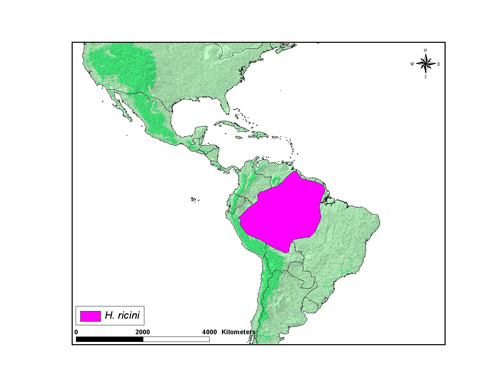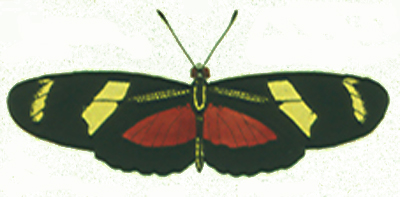Heliconius ricini
Andrew V. Z. Brower and Margarita BeltránIntroduction
A relatively small Heliconius with short antennae, this species was for a long time considered to belong in the genus Eueides. It prefers more open, savanna-type habitats than most Heliconius species, and ranges from Venezuela and Trinidad along the northern part of South America to the Guianas and northern Brazil. Unlike many Heliconius species, H. ricini does not have any sympatric congeners that closely resemble it (although it bears a superficial resemblance to the allopatric H. himera and H. clysonymus).
Characteristics
Early stages: Eggs are yellow and approximately 1.2 x 0.7 mm (h x w). Females usually place 3 to 20 eggs on growing shoots of the host plant. Mature larvae have a yellow body with black spots, and with black scoli and head; length is around 0.8 cm. Caterpillars are gregarious (Brown, 1981).
Adult: H. ricini exhibits two yellow forewing bands and a broad transverse red stripe on the hindwing.
Geographical Distribution
Heliconius ricini occurs in the Amazon basin. This map shows an approximate representation of the geographic distribution of this species. The original data used to draw these maps is derived from Brown (1979) which is available at Keith S. Brown Jr. (1979). Ecological Geography and Evolution in Neotropical Forests.


Distribution of Heliconius ricini. © 2002 Margarita Beltran.
(NB: to the best of my knowledge, H. ricini has not been recorded from Acre or Rondônia, or from Colombia, Peru or Bolivia. It does, however, occur further westward in Venezuela than indicated by the pink area on the map, and on Trinidad, and as far east as Fortaleza on the northern coast of Brazil -- AVZB)
Habits
H. ricini occurs in scrubs and edges. Usually individuals fly slowly. The males sit on female pupae a day before emergence, and mating occurs the next morning, before the female has completely eclosed. Adults roost at night in loose groups under leaves (Brown, 1981).
Host plant: H. ricini larvae feed primarily on plants from the genus Passiflora subgenus Granadilla (Brown, 1981).
Geographical Races
Two geographical races have been described:
- Heliconius ricini ricini (Linnaeus 1758), northern mainland South America
- Heliconius ricini insulanus (Stichel 1909), Trinidad
References
Brown, K. S., Jr. 1981 The biology of Heliconius and related genera. Ann. Rev. Entomol. 26, 427-456.
Lamas, G. (ed.) 2004 Atlas of Neotropical Lepidoptera. Checklist: Part 4A Hesperioidea - Papiionoidea. Gainesville: Scientific Publishers/Association of Tropical Lepidoptera.
Linnaeus C. 1758. Systema naturae per regna tria naturae, secundum classes, ordines, genera, species, cum characteribus, differentiis, synomymis, locis. Editio Decima, reformata. Holmiae, Laurentius Salvius. 1: iv + 823 + [1] pp. ([1 January]) [facsimilar reprint in Mid-Continent Lepidoptera Series 2(23), April 1971]
Title Illustrations

| Scientific Name | Heliconius ricini |
|---|---|
| Reference | Cramer P . 1782. De Uitlandsche Kapellen voorkomende in de drie Waereld-deelen Asia, Africa en America [Papillons Exotiques des Trois Parties du Monde l’Asie, l’Afrique et l’Amerique], Vol. IV. Amsterdam: S. J. Baalde/ Utrecht: B. Wild. Plate 378 |
| Identified By | Andrew V. Z. Brower |
| Scientific Name | Heliconius ricini |
|---|---|
| Reference | Cramer P . 1782. De Uitlandsche Kapellen voorkomende in de drie Waereld-deelen Asia, Africa en America [Papillons Exotiques des Trois Parties du Monde l’Asie, l’Afrique et l’Amerique], Vol. IV. Amsterdam: S. J. Baalde/ Utrecht: B. Wild. Plate 378 |
| Identified By | Andrew V. Z. Brower |
About This Page

Middle Tennessee State University, Murfreesboro, Tennessee, USA

University of Cambridge, Cambridge, UK
Correspondence regarding this page should be directed to Andrew V. Z. Brower at and Margarita Beltrán at
Page copyright © 2010 and
 Page: Tree of Life
Heliconius ricini .
Authored by
Andrew V. Z. Brower and Margarita Beltrán.
The TEXT of this page is licensed under the
Creative Commons Attribution License - Version 3.0. Note that images and other media
featured on this page are each governed by their own license, and they may or may not be available
for reuse. Click on an image or a media link to access the media data window, which provides the
relevant licensing information. For the general terms and conditions of ToL material reuse and
redistribution, please see the Tree of Life Copyright
Policies.
Page: Tree of Life
Heliconius ricini .
Authored by
Andrew V. Z. Brower and Margarita Beltrán.
The TEXT of this page is licensed under the
Creative Commons Attribution License - Version 3.0. Note that images and other media
featured on this page are each governed by their own license, and they may or may not be available
for reuse. Click on an image or a media link to access the media data window, which provides the
relevant licensing information. For the general terms and conditions of ToL material reuse and
redistribution, please see the Tree of Life Copyright
Policies.
- First online 18 February 2007
- Content changed 12 August 2008
Citing this page:
Brower, Andrew V. Z. and Margarita Beltrán. 2008. Heliconius ricini . Version 12 August 2008 (under construction). http://tolweb.org/Heliconius_ricini/72947/2008.08.12 in The Tree of Life Web Project, http://tolweb.org/










 Go to quick links
Go to quick search
Go to navigation for this section of the ToL site
Go to detailed links for the ToL site
Go to quick links
Go to quick search
Go to navigation for this section of the ToL site
Go to detailed links for the ToL site